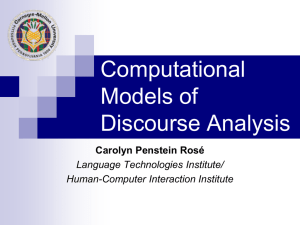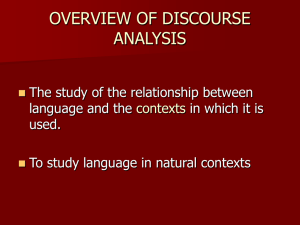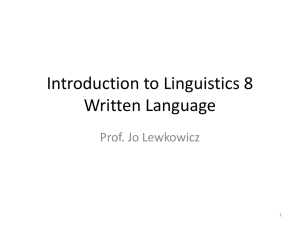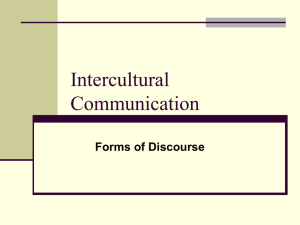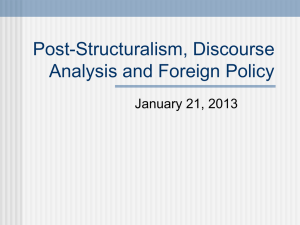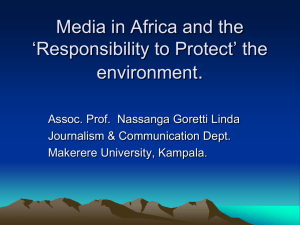HONG KONG INSTITUTE OF EDUCATION Course Outline Part I
advertisement
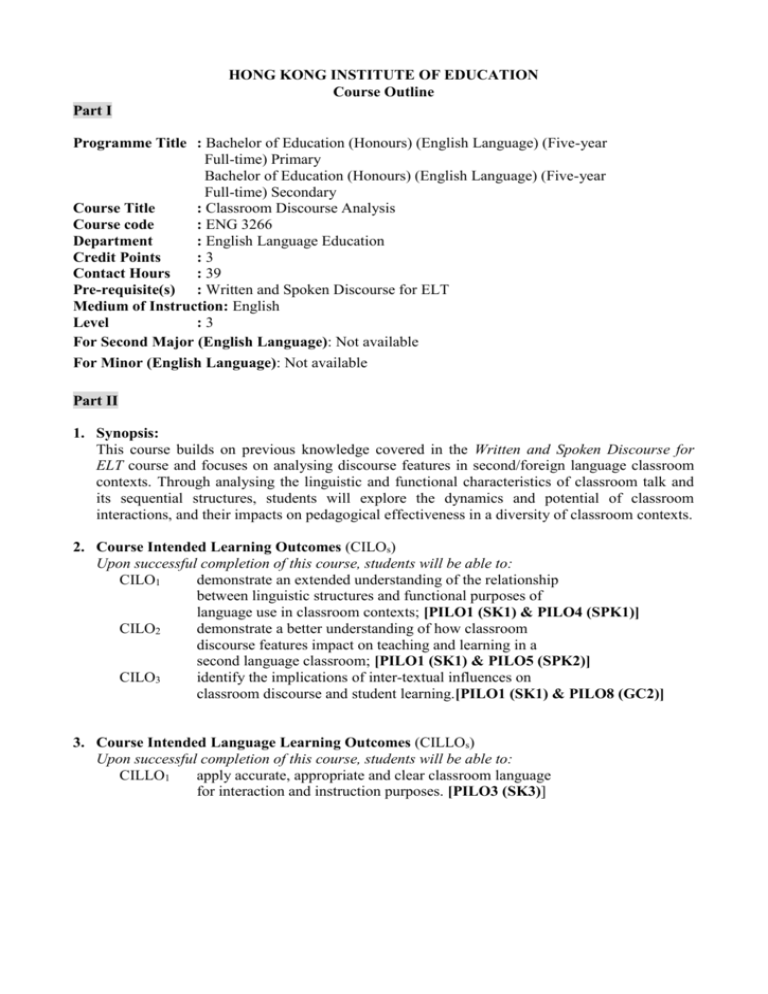
HONG KONG INSTITUTE OF EDUCATION Course Outline Part I Programme Title : Bachelor of Education (Honours) (English Language) (Five-year Full-time) Primary Bachelor of Education (Honours) (English Language) (Five-year Full-time) Secondary Course Title : Classroom Discourse Analysis Course code : ENG 3266 Department : English Language Education Credit Points :3 Contact Hours : 39 Pre-requisite(s) : Written and Spoken Discourse for ELT Medium of Instruction: English Level :3 For Second Major (English Language): Not available For Minor (English Language): Not available Part II 1. Synopsis: This course builds on previous knowledge covered in the Written and Spoken Discourse for ELT course and focuses on analysing discourse features in second/foreign language classroom contexts. Through analysing the linguistic and functional characteristics of classroom talk and its sequential structures, students will explore the dynamics and potential of classroom interactions, and their impacts on pedagogical effectiveness in a diversity of classroom contexts. 2. Course Intended Learning Outcomes (CILOs) Upon successful completion of this course, students will be able to: CILO1 demonstrate an extended understanding of the relationship between linguistic structures and functional purposes of language use in classroom contexts; [PILO1 (SK1) & PILO4 (SPK1)] CILO2 demonstrate a better understanding of how classroom discourse features impact on teaching and learning in a second language classroom; [PILO1 (SK1) & PILO5 (SPK2)] CILO3 identify the implications of inter-textual influences on classroom discourse and student learning.[PILO1 (SK1) & PILO8 (GC2)] 3. Course Intended Language Learning Outcomes (CILLOs) Upon successful completion of this course, students will be able to: CILLO1 apply accurate, appropriate and clear classroom language for interaction and instruction purposes. [PILO3 (SK3)] 4. Content, CILOs and Teaching & Learning Activities Course Content CILOs/CILLOs Function of Language in the Classroom Speech acts and sequential structures (IRF & variations) in classroom discourse; Linguistic and functional categories of classroom discourse: Informing, eliciting, directing, feedback, explaining, managing contingency. Analysing discourse in instructional conversation Examine through the use of audio/ video clips the issue of: how to convey terms/ jargons in subject knowledge (SK) modules to primary/ secondary students in classroom teaching; CILO1,2 CILLO1 Classroom discourse and student learning Linguistics and functional categories of classroom discourse: scaffolding, modifications, comprehensible input, negotiation of input & interaction; Explore teachers’ choice of words in facilitating interaction and other issues of language learning for their target group of students. Input and Interaction Turn allocation & turn taking; Social conventions of turn taking; Cultural factor in students’ participation & identity construction. CILO1, 2 CILO1, 3 CILO1, 3 Suggested Teaching & Learning Activities Lecture Input; Workshop: analyze transcripts some English language classes; Online learning activities Lecture Input; Workshop: watch or review audio/ video clips in some English language classes; Group PPT presentations; Online learning activities Lecture Input; Workshop: analyze transcripts some English language classes; Group PPT presentations; Online learning activities Lecture Input; Workshop: analyze transcripts some English language classes; Group PPT presentations; Online learning activities 5. Assessment Assessment Tasks Weighting (%) a. A portfolio of 2 essay tasks demonstrating mastery of the discourse concepts introduced in the course and application of the concepts in classroom/education settings. The word limit of each essay is 1500. Essay 1: 50% Essay 2: 50% CILOs/CILLOs CILO1, 2,3 CILLO1 6. Required Text(s) Tsui, A.B.M. (1995). Introducing Classroom Interaction. London: Penguin. 7. Recommended Readings Alexander, R.J. (2006). Towards Dialogic Teaching: Rethinking Classroom Talk. Cambridge: Dialogos. 3rd ed. Beck, I.L., McKeown, M.G., Hamilton, R.L & Kucan, L. (1997). Questioning the Author: An Approach for Enhancing Student Engagement with Text. Newark: International Reading Association. Berry, R.A. W. & Englert, C.S. (2005). Designing conversation: book discussions in a primary inclusion classroom. Learning Disability Quarterly, 28 (1), pp. 35 – 58. Bloome, D., Carter, S.P., Christian, B.M., Otto, S., Shuart-Faris, N. (2005). Discourse Analysis and the Study of Classroom Language and Literacy Events. New Jersey: LEA. Brown, G. & Wragg, E.C. (1993). Questioning. [with transcriptions]London: Routledge. Burbules, N.C. (1993). Dialogue in Teaching: Theory and Practice. New York teachers College Press. Ciardiello, A.V. (2007). Puzzle Them First! Motivating Adolescent Readers with Question-Finding. Newark: International Reading Association. Edwards, A.D., & Westgate, D.P.G. (1994). Investigating Classroom Talk (2nd ed.). London: The Falmer press. Godinho, S. (2008). Helping your Pupils to Ask Questions. Abingdon: Routledge. Hall, J. K. (2001). Methods for Teaching Foreign Languages: Creating a Community of Learners in the Classroom. New Jersey: Merrill Prentice Hall. Haroutunian-Gordon, S. (2009). Learning to Teach through Discussion: The Art of Turning the Soul. New Haven: Yale University Press. Hicks, D. (1996). Discourse, Learning and Schooling. Cambridge: Cambridge University Press. Johnson, K.J. (1995). Understanding Communication in Second Language Classrooms. New York: Cambridge University Press. Kurhila, S. (2006). Second Language Interaction. Amsterdam: John Benjamins. Kumpulainen, K. & Wray, D. (2002). Classroom Interaction and Social Learning: From Theory to Practice. London: Routledge. Lynch, T. (1996). Communication in the Language Classroom. Oxford: Oxford University Press. Mackey, A. & Polio, C. (2009) Multiple Perspectives on Interaction: Second Language Research in Honor of Susan M.Gass. New York: Routledge. Mehan, H. (1979). Learning lessons: Social organization in the classroom. Cambridge, MA: Harvard University Press. McMahon, S.I., Raphael, T.E., Goatley, V.J. & Pardo, L.S. (1997). (eds.) The Book Club Connection: Literacy Learning and Classroom Talk. New York: Teachers College Press. Minstry of Education. (2003). Effective Literacy Practice in Years 1 – 4 [with transcriptions]. Wellington, New Zealand: Learning Media Limited. Nassaji, H. & Wells, G. (2000). What’s the use of ‘triadic dialogue? An investigation of teacher-student interaction. Applied Linguistics, 21 (3), pp. 376 – 406. O’Connor, C. & M.S. (2007). When is dialogue ‘dialogic’. Human Development, 50, pp. 275 – 285. Sinclair, J., & Coulthard, M. (1975). Towards an Analysis of Discourse: The Language of Teachers and Pupils. Oxford: Oxford University Press. Skidmore, D. (2000) From pedagogical dialogue to dialogical pedagogy. Language and Education, 14 (4), pp. 283 – 296. Skidmore, D. (2006) Pedagogy and dialogue. Cambridge Journal of Education, 36 (4), pp. 503 – 514. Van der Linden, J. & Renshaw, P. (2004) (eds.). Dialogic Learning: Shifting Perspectives to Learning, Instruction and Teaching. Dordrecht: Kluwer Academic Publishers. Walsh, S. (2006) Investigating Classroom Discourse. London: Routledge. Wells, G. (1993). Reevaluating the IRF sequence: A Proposal for the articulation of theories of activity and discourse for the analysis of teaching and learning in the classroom. Linguistics and Education, 5 (1), pp. 1 – 37. Wells, G. (1999). Language and Education: Reconceptualizing education as dialogue. Annual Review of Applied Linguistics, 19, pp. 135 – 155. Wells, G. (1999). Dialogic inquiry: towards a sociocultural practice and theory of education. New York: Cambridge University Press. Wells, G & Arauz, R.M. (2006). Dialogue in the classroom. The Journal of the Learning Sciences, 15 (3), pp. 379 – 428. Wells, G. (2007). Semiotic mediation, dialogue and the construction of knowledge. Human Development, 50, pp. 244 – 274. Wells, G. (2007). The Mediating role of discoursing in activity. Mind, Culture and Activity, 14 (3), pp. 1 – 18. Wragg, E.C. (2001). Explaining in the Secondary School. London: Routledge/Falmer. Wragg, E.C. (2001). Questioning in the Secondary School. London: Routledge/Falmer. 8. Related Web Resources He, A. & Walker, L. (2004). Corpus of English Language Teaching (CELT). Hong Kong: The Hong Kong Institute of Education. (for restricted use at the English Language Centre, HKIEd) (The corpus has two accompanying handbooks: (1) Using a Corpus of Secondary School Classroom Language: a user's guide with sample tasks; (2) Using Corpus in Classrooms: a user's guide with sample tasks (for primary level).) Hong Kong Education City, Video Library of Teacher-Student Interaction: http://www.hkedcity.net/teacher/teachertv/play.phtml?program_id=154 http://www.hkedcity.net/teacher/teachertv/play.phtml?program_id=284 http://www.hkedcity.net/teacher/teachertv/play.phtml?program_id=3 9. Related Journals Classroom Teaching, Discourse Processes, Discourse & Society, Discourse Studies, Journal of Classroom Interaction, The NATE Classroom and Thinking Classroom

